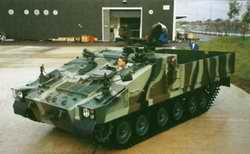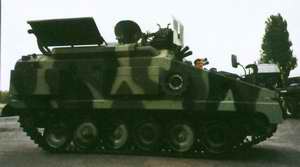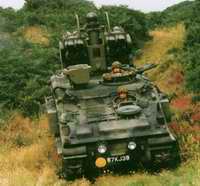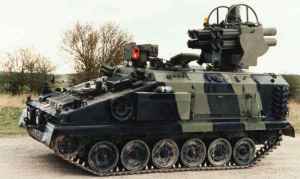| Designation: | Stormer |
 |
|---|---|---|
| Manufacturer: | ALVIS PLC | |
| Product type: | Armoured Vehicles | |
| Name: | Tracked armoured personnel carrier |
In 1980, the now BAE Systems Land Systems purchased the manufacturing and marketing rights of the FV4333 from the British Ministry of Defence.
The vehicle was originally designed by the then Military Vehicles and Engineering Establishment (which no longer exists as such) and the first prototype made a brief appearance at the mobility demonstration at Bovington during the 1978 British Army Equipment Exhibition. In June 1981, the now BAE Systems Land Systems (at that time Alvis) announced that its development of the FV4333 had been designated Stormer.
The Stormer took advantage of the existing technology of the now BAE Systems Land Systems Scorpion CVR(T) family and many of the proven components have been used. The transmission is the same as on the CVR(T) but with a modified input gear train (with the designation changed from TN15 to T300) and the suspension uses CVR(T) components with wheel stations increased either side to six per side.
The hull of the Stormer is wider than the CVR(T) and its original petrol engine was replaced by a Cummins or Perkins Engines Company turbocharged diesel engine.
Late in 1981, Malaysia placed an order for 26 Scorpion 90 vehicles and 25 Stormer APCs, production of which commenced in 1982 with first deliveries made in 1983. Of the Stormer APCs, 12 vehicles are fitted with Thales Land & Joint Systems FVT900 one-person turrets armed with a 20 mm Oerlikon Contraves cannon and a 7.62 mm machine gun and the remainder with a now Rheinmetall Landsysteme TH-1 turret armed with twin 7.62 mm machine guns.
Further development, especially in the area of Reliability, Availability, Maintainability and Durability (RAM-D), resulted in the second-generation Stormer. This vehicle, following a competition, was selected as the platform for the Thales Air Defence UK Starstreak High-Velocity Missile (HVM) system ordered by the British Army.
In 1995, the company completed the last of 145 Stormers for this contract of these, 135 were for the Starstreak High-Velocity Missile (HVM) system and the remaining 10 for the Troop Reconnaissance Vehicle (TRV) requirement.
For operation Desert Storm, the now BAE Systems Land Systems designed and built six specialised platform versions of the vehicle called the Stormer Vehicle Launched Scatterable Mine System (VLSMS). This was fitted with the Nexter Systems (previously Giat Industries) Minotaur scatterable anti-tank minelaying system to meet an urgent operational requirement.
Although it had taken delivery of the Nexter Systems Minotaur system, the British Army subsequently had a competition to meet its main requirement and two systems were then trialled, the Nexter Systems Minotaur and the US Alliant Techsystems Volcano. The latter system was selected with the chassis again being the Stormer flatbed.
The company has also delivered to Oman four Stormer vehicles in the command post configuration. These form part of the GBP140 million contract placed by Oman in 1993, which included the Challenger 2 MBTs and variants as well as UNIPOWER (6 × 6) tank transporters. According to United Nations sources an additional six Stormer vehicles were delivered to Oman in 1999.
For all the specialised roles previously undertaken by members of the Scorpion family, for example armoured personnel carrier (Spartan), ambulance (Samaritan), command post vehicle (Sultan) and recovery vehicle (Samson), the Stormer chassis is now the preferred choice as not only is it a later development but also has a significant increase in internal volume over that of the older versions.
Early in 1995, Indonesia placed a major order for Scorpion 90 vehicles and a complete family of Stormer variants. All these feature the latest upgraded suspension, new Perkins Engines Company Phaser diesel engine and a complete air conditioning system.
The Phaser in the Scorpion 90 is rated at 180 hp and coupled to the David Brown Engineering Limited TN15D transmission, while the Stormer diesel is rated at 250 hp and coupled to a David Brown Engineering Limited T300 transmission.
All the Indonesian Scorpion 90s and Stormer vehicles (with the exception of the recovery and flatbed versions) are fully amphibious and are propelled in the water by their tracks, or using a sprocket-mounted propulsion system.
In addition to the basic armoured personnel carrier version of the Stormer, Indonesia ordered a complete family of variants including command post vehicle, ambulance, recovery, logistic carrier and bridgelayer. The last two vehicles are flatbeds with the bridgelayer carrying a launcher and a Class 30 scissors-type bridge which when opened out is 15 m long.
The first Stormer command post vehicles were shipped to Indonesia in the summer of 1995, within six months of the production order being placed. Final deliveries were made in 1997.
Late in 1996, the company won a second contract from Indonesia for the supply of approximately 50 members of the Scorpion family of light tracked armoured vehicles.
The Indonesian Scorpion/Stormer order was in three phases of which the first two have now been ordered and delivered.
The Indonesian vehicles are powered by a Perkins Engines Company Phaser diesel, have upgraded torsion bar suspension system and air conditioning system.
In addition to the latest Scorpion 90 vehicles, the second contract also included Stormer command post vehicles, armoured personnel carriers, armoured recovery vehicles, ambulances, flatbed cargo carriers and an armoured vehicle-launched bridge carrying a Class 30 scissors bridge.
Production of the Stomer family has been completed and the vehicle is no longer being marketed by BAE Systems Land Systems. Description
The hull of the Stormer is made of all-welded aluminium armour with the driver at the left front, engine compartment to the right and the troop compartment at the rear. The driver has an adjustable seat and a single-piece hatch cover that opens forwards. In front there is a single ×1 day periscope which can be replaced by a passive night driving periscope.
The Perkins Engines (Shrewsbury) T6.3544 diesel is mounted to the right of the driver with air induction through armoured louvres and Farr air cleaners. Engine cooling is by a single mixed-flow fan drawing air through the radiator, over the engine and through the outlet louvres. The exhaust is also cooled by some of this air. The engine is coupled to a David Brown Engineering Limited T300 hot shift, foot-operated, seven-speed gearbox with centrifugal clutch. An automatic shift option for the transmission is available. The transmission contains a controlled differential steering system giving turning circle radii varying with the gear ratio, and a neutral or pivot turn when needed.
From the gearbox the drive goes to the front sprockets and then the tracks. Track adjustment is by hydraulic ram and hand pump.
The company has offered the Stormer with a Cummins diesel engine and the David Brown Engineering Limited T303 automatic transmission. The latter is installed in the Shielder vehicles that have now been delivered to the British Army.
The vehicle commander sits behind the driver and has a No 16 cupola with eight ×1 day periscopes and a periscope with a magnification of ×1 and ×10 for aiming the 7.62 mm GPMG mounted on the right side of the cupola. This can be aimed and fired from within. The cupola has a single-piece hatch cover that opens to the left.
The section leader sits to the right of the vehicle commander and has four day periscopes and a hatch cover.
The number of troops carried depends on the armament installation but it would normally be eight, seated four down either side of the troop compartment on bench seats which can rapidly be folded up to enable stores to be carried. The infantry enters and leaves the vehicle through a large single door that opens to the right and incorporates a single vision block.
Over the top of the troop compartment there is a large two-piece hatch that opens either side of the hull. On the prototype there was no provision for the infantry to aim and fire its small arms from inside the vehicle, but this capability was provided on one of the trials Stormer vehicles.
The torsion bar suspension either side consists of six dual rubber-tyred aluminium road wheels with the drive sprocket at the front and the idler at the rear. Tracks are single pin, steel links, with rubber bushes and integrally mounted rubber pads. The first, second and sixth road wheel stations have hydraulic shock-absorbers. Early Stormers did not have track-return rollers but the latest versions have two per side.
The Stormer has an NBC and/or air conditioning system in the left side of the hull, below the commander's station, and can be fitted with passive night vision equipment. There are two four-barrelled electrically operated grenade dischargers mounted on the front of the hull. Appliqué armour can be added to the vehicle for increased protection.
The basic model can ford to a depth of 1 m without preparation but with a front flotation screen it is fully amphibious, propelled in the water by its tracks at a speed of 6.5 km/h. When fitted with an appliqué propeller kit its water speed is 9.5 km/h.
Optional equipment includes a No 27 cupola, a 7.62 mm machine gun, an NBC system, an air conditioning system, firing ports and vision blocks, a driver's night periscope, night devices for the commander, fire warning and protection equipment, an automatic shift transmission, a flotation screen and fittings, a propeller kit and washboard, communications equipment and a ground navigation system.
Further evaluation of the Stormer design is evident as in early 1991 the Stormer VLSMS (Vehicle-Launched Scatterable Mine System) vehicles were shown. These have a distinctive sharper front end and revised lighting layout. The vehicle is also longer and incorporates radar stealth technology in the outer structure of the vehicle. Further details of this version are given later. Variants
The prototype of the Stormer was fitted with a No 16 cupola armed with a 7.62 mm GPMG but the basic hull can be adapted to mount either a gun or missile turret. This is achieved by modification of the roof section and installation of compatible turret rings.
Under Operation Granby, a quantity (believed to be six) of Stormer Vehicle-Launched Scatterable Mine Systems (VLSMS) was ordered from the now BAE Systems Land Systems late in 1990 and integrated in Coventry with the Minotaur anti-tank mine scattering system from the now Nexter Systems of France. The UK MoD awarded the now BAE Systems Land Systems the first of two contracts early in October 1990 and the first vehicle was built and delivered in just 14 weeks.
These Stormer vehicles were the first to enter service with the British Army in February 1991.
While automotive components of the new Stormer are identical to those of future British Army production Stormers, the hull is of a new design and is both longer and wider.
The driver is seated at the front left of the vehicle with the engine to his right. He has a single-piece hatch cover that opens forward and a single wide-angle day periscope that can be replaced by a passive night periscope if required.
The power pack is to the right of the driver with the vehicle commander seated to the rear of the driver. He operates the minelaying controls and a pintle-mounted 7.62 mm machine gun. There is space to his right for a third crew member.
The driver and commander's compartment has both air conditioning and NBC protection allowing mines to be laid without the crew being exposed to contamination. A bank of four electrically operated, forward-firing 66 mm grenade dischargers is mounted on either side of the vehicle.
The vehicle hull is all-welded aluminium armour and the hull sides have been sloped inwards at the bottom to reduce the radar signature.
Suspension is similar to the standard Stormer except that this version has longer torsion bars and a greater length of track in contact with the ground.
Mounted on the flatbed is the Minotaur scatterable anti-tank mine system.
Although the Minotaur system was adopted for Operation Granby, the British Army had another competition and, early in 1996, the US Alliant Techsystems Volcano system was selected with the Stormer flatbed the platform. A total of 29 Stormer flatbed systems were ordered for this application under the name Shielder.
The first three vehicles were built at Coventry with the main production run being undertaken at Telford with first vehicles being delivered ahead of schedule late in 1999.
The Stormer flatbed can be adopted for a wide range of other roles on the battlefield including repair/recovery and for towing minelaying systems.
The Royal Malaysian Army operates a fleet of 26 Scorpion 90 mm Combat Vehicle (Reconnaissance) Tracked vehicles and 25 Stormer Armoured Personnel Carriers (APCs), which were delivered from 1983.
Of these 25 Stormer APCs, 12 are fitted with a Thales Land & Joint Systems FVT900 series one-person turret armed with a 25 mm cannon and 7.62 mm coaxial machine gun with the remaining 13 being fitted with a German Rheinmetall Landsysteme TH-1 one-person turret armed with twin 7.62 mm machine guns.
To meet the potential requirements of the Royal Malaysian Army Armoured Corps, the Malaysian company of MMC Defence Systems converted one of the latter into a new command post configuration. This is regarded as a concept demonstrator by the company with the eventual configuration depending on inputs from the user.
The one-person manually operated TH-1 twin 7.62 mm machine gun turret has been removed and plated over and mounted on this offset, to the left, is the 7.62 mm weapon station. This is fitted to the Condor (4 × 4) APC variant used in large numbers by the Royal Malaysian Army.
The 7.62 mm machine gun can be aimed and fired with the gunner under complete armour protection, with the weapon station also being provided with a hatch cover and periscopes.
The diesel fuel tank has been repositioned from the floor to the left side of the hull and has the same capacity as the original fuel tank. The bench seat has been removed from the right side to make way for the enhanced communication system, ammunition rack and filing cabinet. Both of the latter are from the Rheinmetall Landsyteme Condor (4 × 4) APC.
A rack for six assault rifles is provided on the left side of the hull with the left bench seat being retained. A map board is also installed.
Four radios are fitted, two VHF for ground/ground communications (front and rear), one HF (ground to air) and one UHF. A commercial generator is carried internally in the left side of the vehicle. This is used to provide dismounted power for the communications equipment when the vehicle is being used in the static role. In this role a large tent can be rapidly erected at the rear of the Stormer command post vehicle to increase available space for the command staff.
To ensure commonality across the Royal Malaysian Army vehicle fleet, MMC Defence Systems have, wherever possible, used proven subsystems that are already in service. The lighting system, for example, is from the SIBMAS (6 × 6) Armoured Fire Support Vehicle (AFSV) of which 162 are in service with the Royal Malaysian Army alongside 24 Armoured Recovery Vehicles (ARVs).
The total crew of the Stormer command post vehicle would depend on the mission, but would typically be six to eight, of which three would be the crew, commander, driver and gunner.
The prototype of the Stormer post vehicle retains the original power pack that consists of the Perkins diesel developing 180 hp coupled to a David Brown Engineering TN15D transmission. But this could be replaced by a more powerful 250 hp Cummins diesel engine, coupled to the latest T300 series transmission.
The suspension has been upgraded with stronger torsion bars fitted as well as Messier dampers that have already been fitted onto the British Army fleet of CVR(T) vehicles. New long horn tracks from ASTRUM (previously William Cook Defence) are fitted, as are new front drive sprockets, with holes to stop the build-up of mud and new return rollers.
The flotation screen has been removed and a bank of three electrically operated 76 mm smoke grenade launchers are fitted on either side of the hull firing forwards.
As of mid-2006, no decision had been taken on the planned upgrade of the Malaysian Stormer vehicles.
In 1986, the Stormer chassis was selected by the British Army as the platform for its Thales Air DefenceStarstreak High-Velocity Missile (HVM) system. Series production of this version commenced at Coventry in late 1991. In this application the Stormer is armed with eight Starstreak missiles in the ready to launch position with additional missiles being carried in reserve. Mounted on the turret roof to the right of the commander's cupola is the Thales acquisition sight and mounted between the two banks of four Starstreak missiles is the Thales Land & Joint Systems Air Defence Alert Device (ADAD), which is passive.
Production of the chassis for the Thales Air Defence Starstreak HVM has been completed, with a total of 135 being built, plus 10 standard Stormer for use in the Troop Reconnaissance Vehicle (TRV) role.
The Thales Air Defence Starstreak HVM system is now operational with the Royal Artillery. Full details of this system, which is only used by the British Army, are given in Jane's Land-Based Air Defence.
|
|||||||||
|
|||||||||||||||||||||
Related Articles |
|
Production of ALAN armored cars is in place in Kazakhstan (10.12.2017) |
 |
 |
 |
 |
 |
 |
 |
 |
 |
 |




